Just as Technology Transformed Agriculture, Harvesting Data Could Reveal Details Down to the Row
USFR-Technology Is Harvesting Data
Over the past four decades, Steve Pitstick's has been on a quest to increase efficiency and perfect production in his northern Illinois fields. The only constant Pitstick sees year to year is change. From too much moisture to not enough, he knows the weather challenges change every year.
“From about the middle of last year through about three weeks ago, we were extremely dry,” he says. “The last 90 days, we had four inches of rain. And then it started raining again, and we have seven inches over about two -week period. So, now we're in pretty good shape.”
With a good mix of rain and sun needed throughout the season to keep the plant’s yield machine running, he’s come to terms with the things he can’t control. It’s what the veteran farmer can control that draws his focus, trying to capture everything he does in every field he farms.
“Every time we cross a field, we are trying to document the herbicides, tillage passes, the planting passes, yield maps,” he says. “We’re trying to get some in season imagery and just trying to gather everything we can.”
Decades of Data
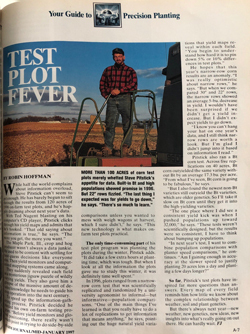
Digesting his farm’s data is nothing new for Pitstick. The precision agriculture “early adopter” was even featured in a 1997 issue of Farm Journal magazine, which captured the learnings from his initial field trials.
“We started in 1996 with a John Deere system,” says Pitstick. “That's one of the first ones around, and now it's pretty much on all machines.”
(Click on the article to read how Steve viewed precision agriculture less than a year into his journey. He says while much has changed from 1997 to 2021, some of the topics from 1997, still apply today.)
On the leading edge of data adoption, data driven decisions became a theme right away. From collecting the data on disks and printing out yield maps boasting an average yield of 168.96 bu.a, to storing his farm's productivity on clouds and accessing it from any combine or tractor, much has changed.
“I have 25 years of data on this farm here where I live,” says Pitstick.
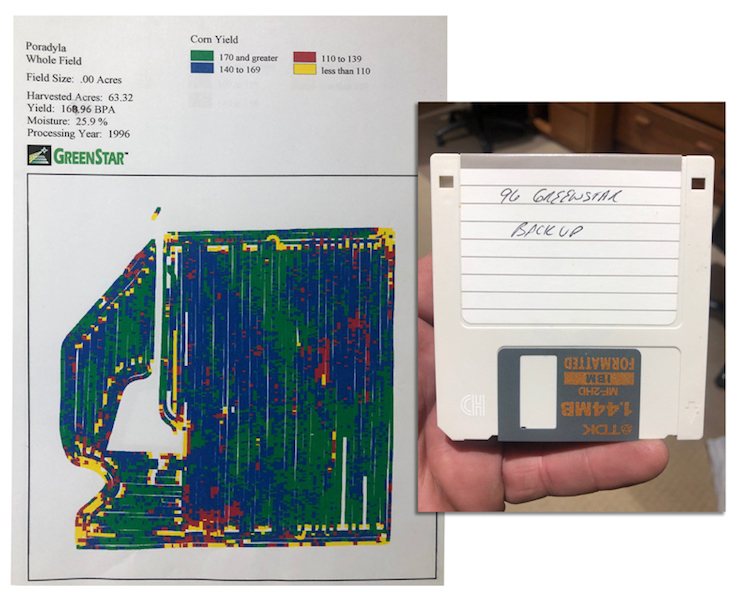
From reaping data off farm fields with every combine pass, to documenting the values used combines and machinery bring at auction, harvesting data has been a useful tool for decades.
“I got my start collecting data in November of 1989 on auction prices, of course, and no one was seeing big data back then,” says Greg Peterson, founder of Machinery Pete. “Actually, I think about the first year after we had some data, we started looking at it and trying to figure out why things were doing what they were doing,”
The days of documenting the numbers on pen and paper, then shifted to digital, when Machinery Pete released the data on the internet starting in 2000. In the decades of data collecting, he understands the amount of data a person can acquire is often overwhelming.
“I think the biggest barrier is just to get numb to the volume of data,” says Peterson. “It can be overwhelming, and it’s easy to tap out, but the thing is, don't tap out. Data, and good data that's reliable and trustworthy, whether it's about using equipment values, or from a section of your field, can make you better,” adds Peterson.
Pitstick says from tillage passes, to planter metrics, to even bouncing the planter across headlands, the more data he digested in initial years of his journey, the quicker he could fix things he was doing wrong.
Harvesting Data
“It was huge,” says Pitstick. “I think early on, we made a lot of things that made 10% differences. In the last five years, it's been much more difficult. So, we're trying to find those 1% or 2% gains, and they're just not as easy to come by.”
While Pitstick has decades of data in his office and on the cloud, the majority of farmers aren’t as immersed in the data as Pitstick.
Kansas State University’s precision agriculture extension specialist Terry Griffin says the data shows despite pieces of precision agriculture planted in various aspects of agriculture since the early 1990s, the majority farmers aren’t fully using their farm data today.
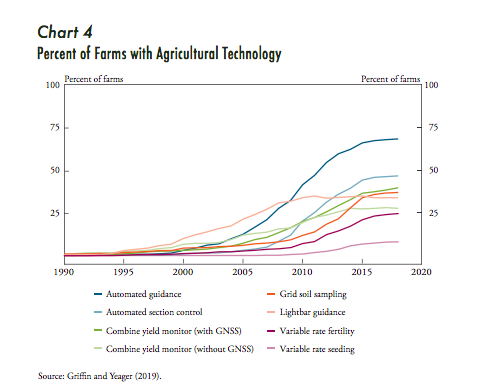
“Less than half of farms are using yield monitors matched with a GNSS or GPS receiver that are able to georeference yield monitor data for use later,” says Griffin. “And given that less than half of farm operations have the technology, we can also assume that many of those who even collect data are not actively using it.”
The biggest barrier in getting started is the initial investment.
“One of the biggest barriers I see at the farm level is the basic economic question of benefits versus the cost,” says Griffin. “The benefits of me actively collecting data outweigh the cost of doing so the investment in the sensors and the human capital cost of managing that data?”
A recent Farm Journal technology survey found while one-quarter of farmers use a trusted advisor to handle their data, 75% collect and process the data on their own.
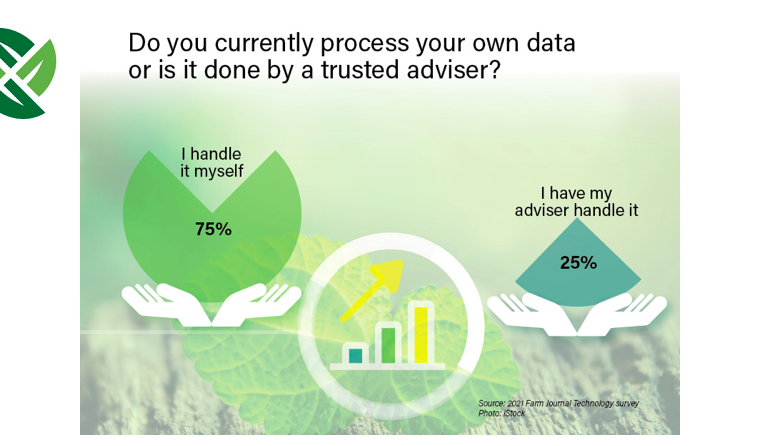
And the ones who use a trusted advisor, 65% say that person is an agronomic consultant, while nearly half say their equipment dealer is a resource.
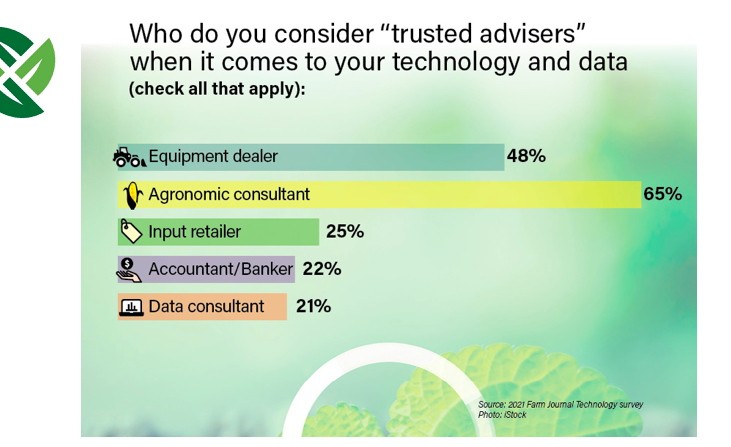
Pitstick says whether it’s to save on costs, or privacy concerns, sharing the data to help package it into useful information to make decisions, often draws concerns.
“I think there's a definite fear with farmers or sharing data, myself included what I do is proprietary. It's my recipe,” says Pitstick. “And I’m competing with the neighbors, and whomever, so I don't want to share that. I spent 45 years trying to figure this out.”
Data-Driven Decisions
As farmers go from just collecting data, to actually using the information to make decisions, the technology has made grand strides. However, how farmers digest the data hasn’t kept the same pace.
“I firmly believe that we are still in the infancy of farm data,” Griffin says.
While farmers may piecemeal the data together to make decision on what hybrids to plant, or areas of the field fertilizer rates need to be tweaked, Griffin says there’s value in aggregating the data to plan for next year.
“My research indicates the greatest use within the farm gate of farm data is the combination of technologies to implement and collect data, implement on farm experiments and collect data from those experiments with which the farm operator will make decisions across many more acres the next year,” says Griffin.
But some of those opportunities planted by agriculture in the future, could actually be off the farm.
“I also believe, according to my research, that the greatest value of farm data will be outside of the farm gates, going to those who can control the flow of data, capture data and analyze it across 1000s of farmers, and millions of acres,” Griffin ads. “Those will be the greatest benefits of farm data in the industry.”
Detailed Data
For farmers fluent in farm data like Pitstick, instead of big picture, he wants to reap detailed data, even focusing in on a single row.
“I think we can get down to maybe row by row on our on our corn heads and looking at what the machine impacts are, what the planters do, what the tillage passes do; if we can look at a lot more minor data, if you will. We have to get the big data right first, and then we'll move down to the smaller stuff that we can actually affect.”
The Quest to Automate
Row by row, field by field, Griffin says the automation element of harvesting data is also essential.
“We in society have been pretty good at automating some tedious tasks, like digging ditches. We've automated that with machinery,” he says. “Unfortunately, we have not been as good at automating some of the tedious task with data.”
As farmers, extension researchers and agribusinesses work to unlock the key to making it easier for farmers to tap into the most valuable data on their farm, Machinery Pete thinks agriculture has barely scratched the surface of the possibilities agricultural data will provide.
“I think scratching the surface doesn't even do it justice,” he says. “I mean, it's the year 2021, where this is going to be down the road, the decisions we can make, the information we're going to use to make them, is going to be completely different.”
A quest to harvest data differently and efficiently that’s been decades in the works, and one that may look drastically different decades down the road.







